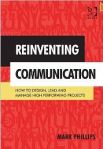A consistent theme running through many of the presentation at both the Project Zone Congress in Germany and the Project Governance and Controls Symposium in Canberra was the importance of effective communication. This is particularly so when dealing with complex projects involving ‘teams of teams’ many of which may be focused on ‘their objectives’ ahead of the overall project.
 Mark Phillips a keynote speaker at PGCS highlighted some of the concepts in his new book ‘Reinventing Communication: How to Design, Lead and Manage High Performing Projects’. Several of the concepts align closely with our views.
Mark Phillips a keynote speaker at PGCS highlighted some of the concepts in his new book ‘Reinventing Communication: How to Design, Lead and Manage High Performing Projects’. Several of the concepts align closely with our views.
The first ‘reinvention’ we fully agree with is the importance of in-person communication – in-person allows energy top build within the communication and facilitates knowledge development by the parties to the communication! Remote communication is limited to knowledge transfer (see more on communication theory).
More important is the need to design your project’s organisation to allow success to be created. The hierarchy of design is:
- Setting the right governance systems, policy and regulations
- Designing the organisation structured to facilitate communication
- Developing the people and the networking environment
- Encouraging open, effective and fearless communication (frightened people won’t communicate bad news)
With the right communication structure and attitudes in place, innovation can thrive leading to problem solving and the creation of the outputs needed for success. Conway’s law (1968) states that ‘that organizations which design systems … are constrained to produce designs which are copies of the communication structures of these organizations’. A fractured communication landscape leads to disjointed project deliverables.
With communication central to success, one of the key strategic intents of the project design should be to engineer an effective communications environment and then to measure the effectiveness of the communications taking place. However, when setting KPIs it is important to measure the effectiveness of the communication, not just the volume!
This is not easy, some of the challenges associated with creating an effective communication environment are discussed in this RSA Animate video – Re-Imagining Work!






